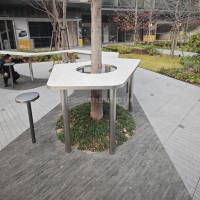Welcome to the website for landscape facilities products and knowledge.
How does the design of a landscape round trash can impact its resistance to damage from falling debris?
The design of a landscape round trash can plays a critical role in its ability to withstand damage from falling debris, such as branches, rocks, or other outdoor elements. A well-engineered round trash can leverages several key design features to improve durability and longevity.
First, the rounded shape distributes impact forces more evenly across the surface, reducing the risk of dents or cracks compared to angular designs. This curvature helps deflect debris, minimizing direct hits on vulnerable points.
Second, material selection is crucial. High-density polyethylene (HDPE) or powder-coated steel offers superior resistance to impacts and weathering. These materials absorb shocks without compromising structural integrity.
Additionally, reinforced bases or weighted bottoms prevent tipping, ensuring the trash can remains stable even when struck by debris. Some designs incorporate flexible yet sturdy construction to absorb kinetic energy from falling objects.
Finally, seamless molding or reinforced seams reduce weak spots where damage might occur. By combining these elements, a landscape round trash can effectively resists damage, making it ideal for parks, streets, and other high-traffic outdoor areas.
In summary, the round shape, robust materials, and strategic reinforcements work together to enhance a trash can's resilience against falling debris, ensuring long-term functionality in harsh environments.
Related search:

Recommendation
An outdoor bar counter with stainless steel and terrazzo materials in an irregular shape